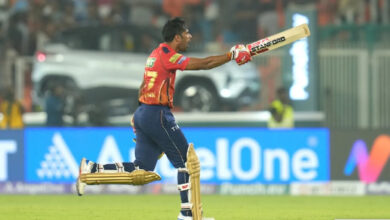India vs Australia: After Ravindra Jadeja, Rohit Sharma ensures India seizes control of Nagpur Test on Day 1

Just after Rohit Sharma clumped Nathan Lyon over mid-wicket, the off-spinner stared suspiciously at the surface. The pitch might have stared back inexpressively at him. Lyon had beaten him three balls ago, some balls before that were scudding low as well, but the 22-yard patch of intrigue and interest seemed to be more benign when Sharma rampaged to an unbeaten 56 off 69 balls, taking India to 77/1 at stumps, exactly a century of runs behind Australia’s total.
Perhaps, this was a case of batsman’s skills providing the pitch a harmless makeover. Perhaps, Australia’s batsmen made it look harder than it actually was. Perhaps, Sharma’s cavalier approach was the way to bat on this low-bounce, slow-turning deck. Maybe, Australia were a fraction overcautious in phases in the first session. Maybe, India’s spinners simply bowled better, tighter and sharper, though without any doubt this was a challenging surface to bat.
Stumps on Day 1️⃣ of the first #INDvAUS Test!#TeamIndia finish the day with 77/1, trailing 100 runs after dismissing Australia for 177 👌🏻
We will see you tomorrow for Day 2 action!
Scorecard – https://t.co/edMqDi4dkU #INDvAUS | @mastercardindia pic.twitter.com/yTEuMvzDng
— BCCI (@BCCI) February 9, 2023
It was a challenging but not an unplayable surface, and none of the 11 wickets, barring that of KL Rahul where the ball gripped and turned and clouded his judgement, originated from the surface playing wicked. Ravindra Jadeja would later say: “This wasn’t a rank turner. It was slow and had low bounce, compared to first-day pitches (in the subcontinent). I felt defending wasn’t difficult today.” He, though, fired a warning: “Defending would be difficult in the coming days.”
There were only two instances of natural variation playing bit-part roles in dismissals, like the wickets of Steve Smith and Pat Cummins. But other than those instances, the bowlers should feature in the credit role. A variety of approaches worked. The grind and aggression of Marnus Labuschagne and Smith in the first session, wherein they soaked the early dangers and stroked some glorious shots in their 82 run-association. Labuschagne especially looked unalarmed — he drove Ravichandran Ashwin, bowled from around the stumps he played inside out through extra cover for three before he paddle-swept him for a four, Smith gorgeously drove Axar Patel through the covers. It was the classical method, classical as the batsmen too are.
The approach of wicket-keeper batsman Alex Carey was entirely different. He would sweep and reverse sweep to glory for his 33-ball 36, and it was he who rattled India’s spinners more than Smith and Labuschagne, where the spinners knew that a killer ball was lurking and it was a matter of pressing and probing. But Carey’s reverse-sweep induced mayhem, with Sharma even summoning Siraj for a spell, only to be taken after Carey sliced and drove him for a pair of boundaries in an over, before creaming for another two in the next over. The fields and plans were frequently switched, bowlers changed ends and angles, the virtue of patience that was India’s guiding star until that moment seemed to wane. Even Ravindra Jadeja had his hands on head when he reverse-swept him off his stumps. It took Ashwin to end his cameo, ended a reverse-sweep that he under-edged. But no other remaining Australian batsman could replicate his approach. The lone other surviving special batsman was Peter Handscomb, who is more a grinder than an aggressor, whose 31 came off 87 sweaty balls, where he repeatedly played and missed outside the batsman.
Then Sharma arrived with a flurry of boundaries. The first, an edge through the slips cordon, but the rest were insuperably timed. He took toll on Cummins’s unusual leg-side gifts before snuffing the fangs of Lyon, India’s predominant threat throughout the innings and beyond, sweeping, driving and thumping him. His scoring rate will have you misinterpret that he was taking risks. He was not often, rather he was hitting boundaries off even semi-loose balls and trusting his percentage strokes and defence. His knock had a Carey-like effect on Australia’s bowlers. They chose defensive lengths and fields, set elaborate traps, and yet Sharma fetched boundaries and reduced India’s deficit to 100 runs.
In doing so, he might have laid the blueprint of batting on this surface, which would progressively get worse for batting as the surface wears on and the redness beneath turns the more prominent colour. A method wherein a batsman is neither counter-attacking nor stonewalling, but maximising the boundary-scoring opportunities, deducing the shots that would work and that wouldn’t, always aware of the reality that one ball could grip, turn and could even leap.
For bowlers, this would be a patience game, where like Jadeja, Lyon and Co should string dot balls, ratchet up the pressure and frustrate the batsmen into doing something silly, and play the cat and mouse game occasionally. If an unplayable gift of the surface ball arrives, consider it a bonus rather than praying for the pitch to crack open and perform magic every time they ping the ball. That’s a folly a lot of overseas spinners make in spin-friendly subcontinent conditions — just like Asian seamers when they travel abroad. They get carried away and end up getting frustrated, lose control over their plan and mess up with the lengths.
That’s a 5-wicket haul for @imjadeja 💥🫡🔥
His 11th in Test cricket.
Live – https://t.co/edMqDi4dkU #INDvAUS @mastercardindia pic.twitter.com/Iva1GIljzt
— BCCI (@BCCI) February 9, 2023
There are lessons they could glean from their own innings, where wickets fell in a heap after a seemingly placid partnership. They lost Usman Khawaja and David Warner in the space of six balls; Labuschagne and Renshaw in two. Later, Handscomb would explain the trend: “This is exactly what we would be looking for tomorrow (second day). We believe there is still a lot left in the game and a few early wickets would give us a great chance of pushing for an advantage.” And the lesson for India is that no matter how plain it might look at times, it could turn stormy any second. The pitch that Lyon stared suspiciously might smile back at him on the second day.







